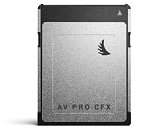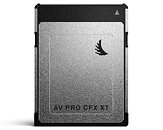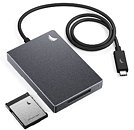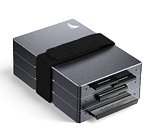Monday, September 9th 2019
Angelbird Announces CFexpress Cards
Angelbird Technologies, the premier developer of camera-specific media for professional creatives, announces the addition of CFexpress Type B memory cards to their high-performance lineup of AV PRO media solutions.The call for quick adoption of advanced digital video production standards to 6K, 8K and beyond, is being driven by high-profile international broadcasting as well as an increased need for industrial data processing and performance requirements. CFexpress memory media meets the high-speed demands of new technology (media that can write data at a minimum of 400 MB/sec).
It also mirrors the XQD form factor-- allowing select cameras that currently utilize XQD to now also accept CFexpress with a firmware update. But different from XQD, is that the CFexpress adopts the PCIe Gen 3 interface standards promoted by the CompactFlash Association. Angelbird's AV PRO CFX and AV PRO CFX XT offer read/write speeds up to 1700 MB/s and 1400 MB/s. CFexpress memory cards perform at speeds 3.5x faster than CFast technology- the current memory card leader for high-bitrate video production.One additional advantage of CFexpress media, is that it offers longevity. CFexpress technology will remain relevant for years to come since it can already support the speeds required to capture 8K recording resolution even though 8K camera technology is still in development.
Angelbird's CFexpress cards offers real-world, sustained performance that will write data consistently without performance drop-offs, thus avoiding choppy footage or dropped frames. While both the Angelbird AV PRO CFX and AV PRO CFX XT offer competitive sustained performance, their ideal applications may vary according to the specific production needs of the user.
The AV PRO CFX is best suited for production work that requires a minimum guaranteed write speed of 550 MB/s, a recording speed still well above the current XQD-400 standard of 400 MB/sec, with capacities of up to 1 TB. Creative professionals working at the leading edge of digital production will find that the CFexpress memory card is the ideal media for content production that demands 4k and 6K+ resolution.
The AV PRO CFX XT is the best rock-solid option for optimal sustained write performance. With its 1 GB/s sustained write speeds the 4-6-8K resolutions will be able to be captured uncompressed RAW. The AV PRO CFX XT is ideal for high-capacity frame rate capture needs with data capacities up to 640 GB.
While the future standards for creative production rely on increased processing speeds, industrial applications, from security cameras to quality control imaging, require stable, sustained data capture for their extended recording needs. The AV PRO CFX XT combines a sustained write performance with high capacity storage up to 640 GB.
The reading and processing of data captured on CFexpress cards will require a capable CFexpress reader that can also efficiently transfer large data files for post-production work. Angelbird will also release a CFEXPRESS CARD READER which performs at speeds in tandem with the AV PRO CFX and AV PRO CFX XT cards and modularly stacks with Angelbird's CFast 2.0 and SD card readers.
The CFexpress Card Reader includes Type-C to Type-C cable (50 cm, 19.7 in) and active USB-A to USB-C adapter, along with non-slip rubber pads for added stability during operation and Velcro binding for easy portability. The recessed Solid Connect (USB 3.1 Gen 2, 10 Gb/s) connection port helps to provide a secure connection point and minimize wear and tear. Through customer feedback, we have implemented a "Write Protect" function into all of our card readers. By enabling this switch, the user can feel secure to not delete or erase anything by mistake. This feature is supported for Mac, Windows, Linux and Android.
Angelbird's CFexpress memory cards are the latest addition to the AV PRO product line which push the limits of speed and performance in the safest possible way. All AV PRO media solutions (SD, CFast 2.0, CFX, micro SD, and SSD 2.5") consider the real-world media needs of the professional creative and feature Stable Stream performance technology, ideal for high-definition, lossless (drop-fee) video recording and smooth data processing.
The entire lineup of Angelbird's AV PRO media solutions are built with rock-solid performance protections such as, shock, dust, X-ray, and splash-water proofing, and are tested for safe operating temperatures at extremes of (-25C to +85C).
Angelbird offers free professional data recovery service on all its products. Rather than a providing a self-service software download, Angelbird provides a staff of professionals who will evaluate the issue and safely attempt a secure data-recovery in their lab, care of complementary overnight shipping.
This service covers media that has encountered physical damage and/or software issues such as data or file corruption. Furthermore, Angelbird extends a non-disclosure agreement to their customers to ensure that the privacy and confidentiality of their content is also protected.
It also mirrors the XQD form factor-- allowing select cameras that currently utilize XQD to now also accept CFexpress with a firmware update. But different from XQD, is that the CFexpress adopts the PCIe Gen 3 interface standards promoted by the CompactFlash Association. Angelbird's AV PRO CFX and AV PRO CFX XT offer read/write speeds up to 1700 MB/s and 1400 MB/s. CFexpress memory cards perform at speeds 3.5x faster than CFast technology- the current memory card leader for high-bitrate video production.One additional advantage of CFexpress media, is that it offers longevity. CFexpress technology will remain relevant for years to come since it can already support the speeds required to capture 8K recording resolution even though 8K camera technology is still in development.
Angelbird's CFexpress cards offers real-world, sustained performance that will write data consistently without performance drop-offs, thus avoiding choppy footage or dropped frames. While both the Angelbird AV PRO CFX and AV PRO CFX XT offer competitive sustained performance, their ideal applications may vary according to the specific production needs of the user.
The AV PRO CFX is best suited for production work that requires a minimum guaranteed write speed of 550 MB/s, a recording speed still well above the current XQD-400 standard of 400 MB/sec, with capacities of up to 1 TB. Creative professionals working at the leading edge of digital production will find that the CFexpress memory card is the ideal media for content production that demands 4k and 6K+ resolution.
The AV PRO CFX XT is the best rock-solid option for optimal sustained write performance. With its 1 GB/s sustained write speeds the 4-6-8K resolutions will be able to be captured uncompressed RAW. The AV PRO CFX XT is ideal for high-capacity frame rate capture needs with data capacities up to 640 GB.
While the future standards for creative production rely on increased processing speeds, industrial applications, from security cameras to quality control imaging, require stable, sustained data capture for their extended recording needs. The AV PRO CFX XT combines a sustained write performance with high capacity storage up to 640 GB.
The reading and processing of data captured on CFexpress cards will require a capable CFexpress reader that can also efficiently transfer large data files for post-production work. Angelbird will also release a CFEXPRESS CARD READER which performs at speeds in tandem with the AV PRO CFX and AV PRO CFX XT cards and modularly stacks with Angelbird's CFast 2.0 and SD card readers.
The CFexpress Card Reader includes Type-C to Type-C cable (50 cm, 19.7 in) and active USB-A to USB-C adapter, along with non-slip rubber pads for added stability during operation and Velcro binding for easy portability. The recessed Solid Connect (USB 3.1 Gen 2, 10 Gb/s) connection port helps to provide a secure connection point and minimize wear and tear. Through customer feedback, we have implemented a "Write Protect" function into all of our card readers. By enabling this switch, the user can feel secure to not delete or erase anything by mistake. This feature is supported for Mac, Windows, Linux and Android.
Angelbird's CFexpress memory cards are the latest addition to the AV PRO product line which push the limits of speed and performance in the safest possible way. All AV PRO media solutions (SD, CFast 2.0, CFX, micro SD, and SSD 2.5") consider the real-world media needs of the professional creative and feature Stable Stream performance technology, ideal for high-definition, lossless (drop-fee) video recording and smooth data processing.
The entire lineup of Angelbird's AV PRO media solutions are built with rock-solid performance protections such as, shock, dust, X-ray, and splash-water proofing, and are tested for safe operating temperatures at extremes of (-25C to +85C).
Angelbird offers free professional data recovery service on all its products. Rather than a providing a self-service software download, Angelbird provides a staff of professionals who will evaluate the issue and safely attempt a secure data-recovery in their lab, care of complementary overnight shipping.
This service covers media that has encountered physical damage and/or software issues such as data or file corruption. Furthermore, Angelbird extends a non-disclosure agreement to their customers to ensure that the privacy and confidentiality of their content is also protected.





8 Comments on Angelbird Announces CFexpress Cards
NVMe is also very power hungry, meaning your camera would need a larger battery, a cooling system, a pcie controller and other things cameras are not designed around.
did you read the article? 1.7 GB/s/1.4GB/s read/write speed isnt enough for you? These cards are pushing NVMe gen 1 speeds already, without the drawbacks, in a design meant to be moved. CFexpress uses the NVMe standard as well!
Same with the thunderbolt controller. Now you have to design a thunderbolt controller, its circuitry, ece and pay for the license, as opposed to you putting a CFexpress reader in your PC instead. Just connect your enclosure to your PC.
Even if you have to sell inexpensive enclosures to put the drives in for ease of use and protection and a special inexpensive SATA to USB reader to accept the drives in the enclosures.
You guys are trying to reinvent the wheel to justify using a different interface which will be just as expensive as just buying the CFexpress card and reader. You gain nothing from jerry-rigging a M.2 connector into a camera. What are you going to do with it? Take it out and disassemble your computer every time you want to pull big files? And since M.2 connectors on PCs are routed through PCIe, which is not hot swappable, you would need to shut off your PC to do so. You would need an external reader with its own mechanism, which CFexpress ALREADY DOES FOR YOU. If you dont need such high speeds, XDR exists.
There also already exist cameras with built in USB 3 connectors for those of you that really hate removable media. Most professionals (the main market for this stuff) want removable drives because they will fill several cards during a job or string of jobs. They are not going to want a camera with permanent built in storage, no matter how cheap it is to DIY a storage upgrade.
On the other hand, SATA controllers are cheap. SATA M.2 SSDs are cheap. Heck, SATA M.2 enclosures pretty much already exist, and guess what, they're cheap too! Who cares about NVMe gen 1 speeds, that isn't necessary. SATA is already fast enough for 8K video. Making the storage media faster isn't really helping anyone, make it cheaper instead.That's specifically why I said put it in an enclosure to protect it. Adapt it to a USB-C connector if you want, those are readily available and cheap.This statement is 100% backwards. CFExpress is re-inventing the wheel with their standard. They're just adapting NVMe that to a new proprietary format and charging out the ass for it. CFExpress is just the PCI-E NVMe SSD in a different form factor that's stupid expensive. Hell, their CFast cards are just SATA SSDs in a different form factor and they charge $280 for a 256GB drive! I don't even want to know what they are going to try charging for CFExpress. I guarantee, if someone put a little effort into it, they could come up with something significantly cheaper using largely already available off the shelf parts.
I mean, your biggest argument against it is that the M.2 connector isn't robust enough to be inserted and removed. That's the easiest, and cheapest, problem to solve ever. You just design a PCB with direct wiring to a connector that is robust enough. Everything else is off the shelf controllers in the cameras and readers. Hell, USB-C has already been adapted to PCI-E x2, so the work is pretty much already done.You realize that we're talking about removable media, not internal media, right? Like, it isn't that hard to make an M.2 drive into removable media.
Again, the target market is PROFESSIONALS, not tinkerers that want to be cheap-asses about photo storage.You're right, it isnt, thats why Cfast and XDR already exist. If you want to be cheap, just use SD cards FFS.:roll::banghead::roll: Are you serious right now?
Let me explain what Re-invent the wheel means: it means doing something from the start without purpose, wasting resources. Or, alternatively, "waste a great deal of time or effort in creating something that already exists "
Lets look at CFexpress. It allows for significantly higher transfer rates for transferring large video or RAW files, increasingly common with newer cameras, as well as offering larger storage then XDR solutions, while ALSO getting around XDR's licensing and supply limitations. It takes the NVMe standard and makes it portable and durable for use on the go in various environments. It has taken off the shelf hardware and put it into a enclosure to protect it, EXACTLY what you are suggesting we do with SATA, which was already done with Cfast. The only proprietary part of the device is the connector (done because M.2 is not built for constant engagement/disengagement) and the price reflects hardened NAND (go look at any industrial NAND, which is what is used here, and you will see the prices are right in line with what is expected in the market.)
Such technology does not currently exist in the camera market.
Now, lets look at your solution; which is to take pre existing tech (sata SSDs) and put them into enclosures that would connect over USB. This would provide slower speeds then UHS-III SD cards, cost more then UHS-III SD cards, and already exist in the form of cameras that take 2.5" SSDs. Given your constant nagging about CHEAP! you would likely not be using high end SSDs, but rather cheap ones, so likely you would be running 100-200 MB slower then current gen SD cards. Your solution would also be larger, more cumbersome, and would also rely on dongles to connect them to PCs, as opposed to card readers which most camera owners already have.
Your solution is more expensive, more cumbersome, and doesnt achieve any improvement over currently existing SD card tech. Cameras with 2.5" SATA connectors already exist.
Which one of us is reinventing the wheel here?
And, again, this would be a significantly cheaper solution while still giving the same robustness and performance a CFast or CFExpress. In fact, the camera manufacturers would only need to sell the small enclosures, which would cost only a few dollars to manufacture. The consumer could then buy whatever M.2 SSD they wanted and put it in the enclosure. This solution would provide literally everything CFExpress provides, while being significantly cheaper AND allowing the end user more flexibility in picking what storage they are actually using. If they want to be cheaper and use a consumer SSD, they can. If they want to spend a little more(but still way less than a CFExpress card) and use an industrial SSD, they can.No its not.An M.2 drive in a cartridge style enclosure wouldn't really be any bigger than a CFExpress card volume wise. So, not more cumbersome either.Yeah, it would be just as fast as CFast or CFExpress(depending on what type of SSD the cartridge enclosure would accept). So are you saying CFast and CFExpress don't achieve any improvement over currently existing SD card tech?CFExpress is, we've already established this.